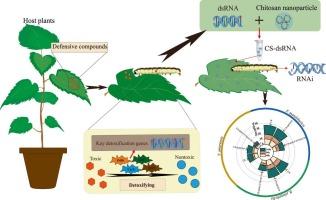HcCYP6AE178 plays a crucial role in facilitating Hyphantria cunea's adaptation to a diverse range of host plants
IF 4.2
1区 农林科学
Q2 BIOCHEMISTRY & MOLECULAR BIOLOGY
引用次数: 0
Abstract
Strong multi-host adaptability significantly contributes to the rapid dissemination of Hyphantria cunea. The present study explores the involvement of cytochrome P450 monooxygenase (P450) in the multi-host adaptation of H. cunea and aims to develop RNA pesticides targeting essential P450 genes to disrupt this adaptability. The results showed that inhibiting P450 activity notably reduced larval weight and food-intake across seven plants groups. The P450 gene HcCYP6AE178 was highly upregulated in H. cunea larvae from medium- and low-preference host plant groups. Silencing HcCYP6AE178 significantly decreased H. cunea larval body weight, increased larval mortality, inhibited energy metabolism genes expression and interfered with growth regulatory genes expression. Overexpression of HcCYP6AE178 enhanced the tolerance of Drosophila and Sf9 cells to the plant defensive substances cytisine and coumarin. The RNA pesticide CS-dsHcCYP6AE178 constructed using chitosan (CS) exhibited remarkable stability. Treatment with CS-dsHcCYP6AE178 effectively reduced H. cunea larval body weight, heightened larval mortality, and disrupted growth regulatory genes expression in low-preference host plant groups. Combined treatment of CS-dsHcCYP6AE178 and coumarin significantly elevated H. cunea larval mortality compared to coumarin alone, accompanied by the inhibition of growth regulatory genes expression and an abnormal increase in energy metabolism genes expression. Taken together, HcCYP6AE178 is essential for the adaptation of H. cunea to multiple host plants, and RNA pesticides targeting HcCYP6AE178 can effectively impair the performance of H. cunea in different host plants.

HcCYP6AE178 在促进楔叶象甲适应多种寄主植物方面发挥着关键作用
强烈的多宿主适应性是楔尾象甲迅速传播的重要原因。本研究探讨了细胞色素 P450 单加氧酶(P450)在楔尾蝇多寄主适应性中的参与作用,并旨在开发针对重要 P450 基因的 RNA 杀虫剂来破坏这种适应性。结果表明,抑制 P450 活性可显著降低七个植物组的幼虫体重和摄食量。P450基因HcCYP6AE178在中偏好和低偏好寄主植物组的楔尾蝇幼虫体内高度上调。沉默 HcCYP6AE178 能显著降低楔尾蝇幼虫体重,增加幼虫死亡率,抑制能量代谢基因的表达,干扰生长调节基因的表达。过表达 HcCYP6AE178 能增强果蝇和 Sf9 细胞对植物防御物质胞嘧啶和香豆素的耐受性。利用壳聚糖(CS)构建的 RNA 杀虫剂 CS-dsHcCYP6AE178 具有显著的稳定性。CS-dsHcCYP6AE178能有效降低胭脂虫幼虫体重,增加幼虫死亡率,并干扰低偏好寄主植物群中生长调节基因的表达。与单独使用香豆素相比,CS-dsHcCYP6AE178 和香豆素联合处理可显著提高胭脂虫幼虫的死亡率,同时抑制生长调节基因的表达,并使能量代谢基因的表达异常增加。综上所述,HcCYP6AE178对于楔尾蝇蛆适应多种寄主植物至关重要,以HcCYP6AE178为靶标的RNA杀虫剂可以有效地损害楔尾蝇蛆在不同寄主植物中的表现。
本文章由计算机程序翻译,如有差异,请以英文原文为准。
求助全文
约1分钟内获得全文
求助全文
来源期刊
CiteScore
7.00
自引率
8.50%
发文量
238
审稿时长
4.2 months
期刊介绍:
Pesticide Biochemistry and Physiology publishes original scientific articles pertaining to the mode of action of plant protection agents such as insecticides, fungicides, herbicides, and similar compounds, including nonlethal pest control agents, biosynthesis of pheromones, hormones, and plant resistance agents. Manuscripts may include a biochemical, physiological, or molecular study for an understanding of comparative toxicology or selective toxicity of both target and nontarget organisms. Particular interest will be given to studies on the molecular biology of pest control, toxicology, and pesticide resistance.
Research Areas Emphasized Include the Biochemistry and Physiology of:
• Comparative toxicity
• Mode of action
• Pathophysiology
• Plant growth regulators
• Resistance
• Other effects of pesticides on both parasites and hosts.

 求助内容:
求助内容: 应助结果提醒方式:
应助结果提醒方式:


